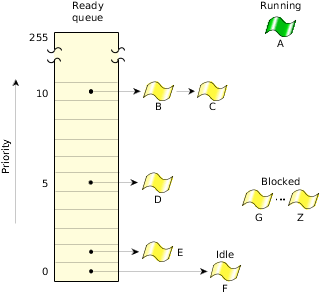Every thread is assigned a priority. The thread scheduler selects the next thread to run by looking at the priority assigned to every thread that is READY (i.e., capable of using the CPU). The thread with the highest priority is selected to run.
The following diagram shows the ready queue for five threads (B–F) that are READY. Thread A is currently running. All other threads (G–Z) are BLOCKED. Thread A, B, and C are at the highest priority, so they'll share the processor based on the running thread's scheduling policy.
 Figure 1. The ready queue.
Figure 1. The ready queue.The OS supports a total of 256 scheduling priority levels. An unprivileged thread can set its priority to a level from 1 to 63 (the highest priority), independent of the scheduling policy. Only threads with the PROCMGR_AID_PRIORITY ability enabled (see procmgr_ability()) are allowed to set priorities above 63. The special idle thread (in the process manager) has priority 0 and is always ready to run. A thread inherits the priority of its parent thread by default.
You can change the allowed priority range for unprivileged processes with the procnto -P option:
procnto -P priority
In QNX Neutrino 6.6 or later, you can append an s or S to this option if you want out-of-range priority requests by default to use the maximum allowed priority (reach a "maximum saturation point") instead of resulting in an error. When you're setting a priority, you can wrap it in one these (non-POSIX) macros to specify how to handle out-of-range priority requests:
- SCHED_PRIO_LIMIT_ERROR(priority)—indicate an error
- SCHED_PRIO_LIMIT_SATURATE(priority)—use the maximum allowed priority
Here's a summary of the ranges:
| Priority level | Owner |
|---|---|
| 0 | Idle thread |
| 1 through priority − 1 | Unprivileged or privileged |
| priority through 255 | Privileged |
Note that in order to prevent priority inversion, the kernel may temporarily boost a thread's priority. For more information, see "Priority inheritance and mutexes" later in this chapter, and "Priority inheritance and messages" in the Interprocess Communication (IPC) chapter. The initial priority of the kernel's threads is 255, but the first thing they all do is block in a MsgReceive(), so after that they operate at the priority of threads that send messages to them.
The threads on the ready queue are ordered by priority. The ready queue is actually implemented as 256 separate queues, one for each priority. The first thread in the highest-priority queue is selected to run.
Most of the time, threads are queued in FIFO order in the queue of their priority, but there are some exceptions:
- A server thread that's coming out of a RECEIVE-blocked state with a message from a client is inserted at the head of the queue for that priority—that is, the order is LIFO, not FIFO.
- If a thread sends a message with an "nc" (non-cancellation point) variant of MsgSend*(), then when the server replies, the thread is placed at the front of the ready queue, rather than at the end. If the scheduling policy is round-robin, the thread's timeslice isn't replenished; for example, if the thread had already used half its timeslice before sending, then it still has only half a timeslice left before being eligible for preemption.